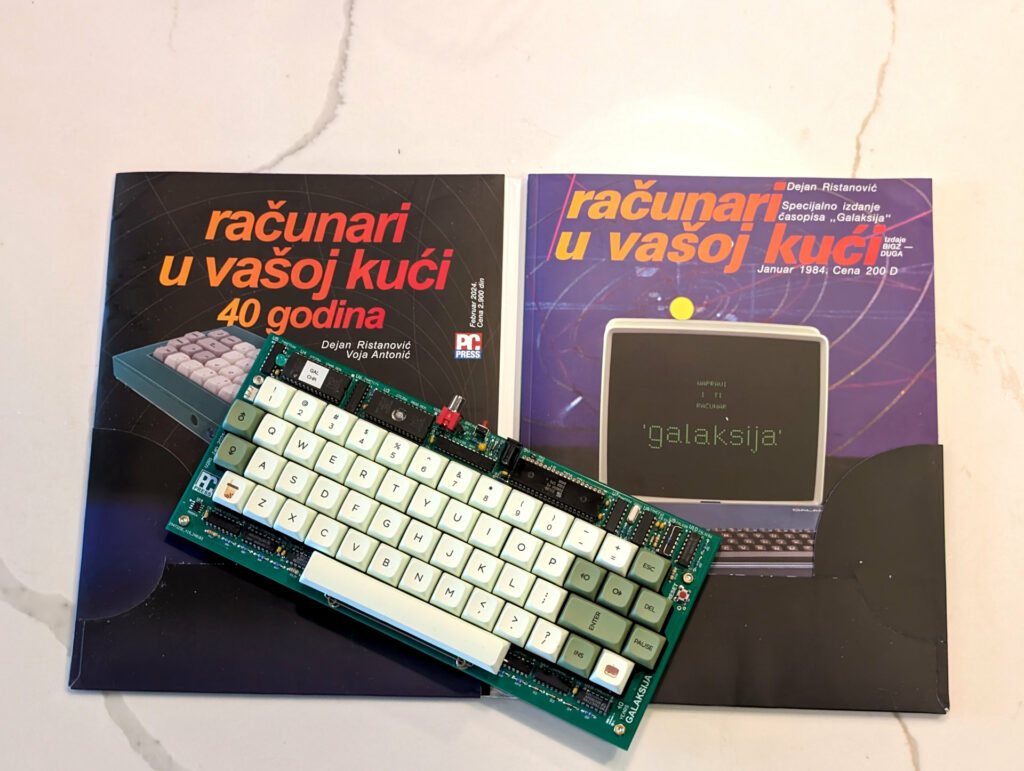
In the 2020s we’re celebrating many anniversaries related to the early days of home computing: 2022 marked the 40th anniversary of the ZX Spectrum and the Commodore 64, and the recent celebration of the 40 years of the Apple Macintosh made a big splash in the mainstream media. In another part of the world 40 years ago, the Galaksija computer and its accompanying publication Računari u vašoj kući arrived on the scene. They changed the lives of thousands of people in what used to be called Yugoslavia.
While the story of the Galaksija almost seemed forgotten in the 1990s and the early 2000s, this unique computer has gone through a significant renaissance in recent years, in the countries of the former Yugoslavia and beyond. If this is the first time you’re hearing about the Galaksija, I recommend you read my Making A Galaksija Computer FAQ and check out my talk at HOPE 2022 to learn more about how the Računari u vašoj kući magazine and the Galaksija computer brought microcomputers to Yugoslavia at a time when virtually no-one was able to get them legally. You may find this story fascinating and relatable even if you have no particular interest in the history of technology from formerly non-aligned socialist countries.
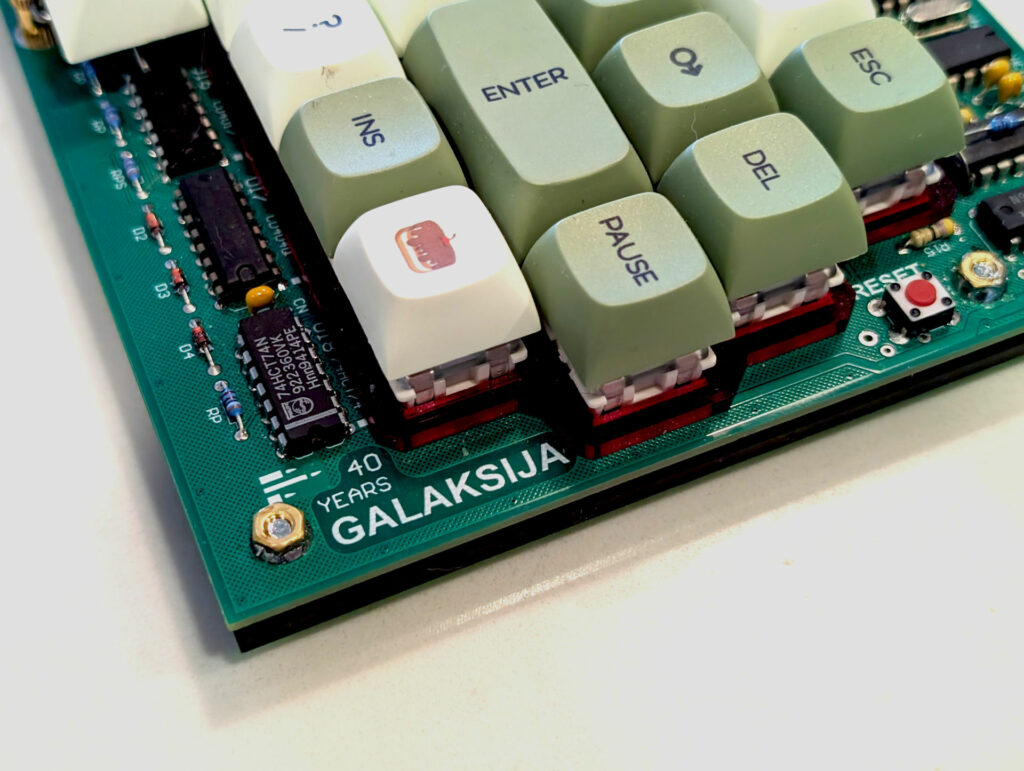
Many communities dedicated to famous computers like the ZX Spectrum and the Commodore 64 organized tributes to mark these computers’ anniversaries. But the Galaksija is getting celebrated in a truly special way: Dejan Ristanović and Voja Antonić, the duo behind the original project, have teamed up once again to celebrate both the Galaksija computer and the publication that made it possible, by releasing beautiful reproductions of both!
Računari u vašoj kući reprint
Whenever I write or speak about the Galaksija, I always stress the importance of the magazine that launched it. Računari u vašoj kući (“Computers in your home”) magazine didn’t just make the Galaksija computer famous – it literally made it possible. Galaksija was conceived, and largely realized, as a primarily DIY design that was freely distributed through a magazine. Računari u vašoj kući had to achieve so many simultaneous things: educate a largely uninformed public about what computers even were, explain to that same public that they themselves could construct an actual computer themselves, and then provide clear enough instructions and access to parts so that those folks could legally build a fully functional microcomputer. This was an achievement of enormous proportions.
Even though the magazine went through multiple prints, with tens of thousands copies sold at the time, the original issue is difficult to find these days. It was printed on cheap, newspaper style paper, and the quality of the print was poor even in the 1980s. Even though it’s been scanned and available online for many years (including the English translation of the instructions published in PoC——GTFO, Volume 2), the printed version is still the best way to appreciate this seminal moment in computing history.
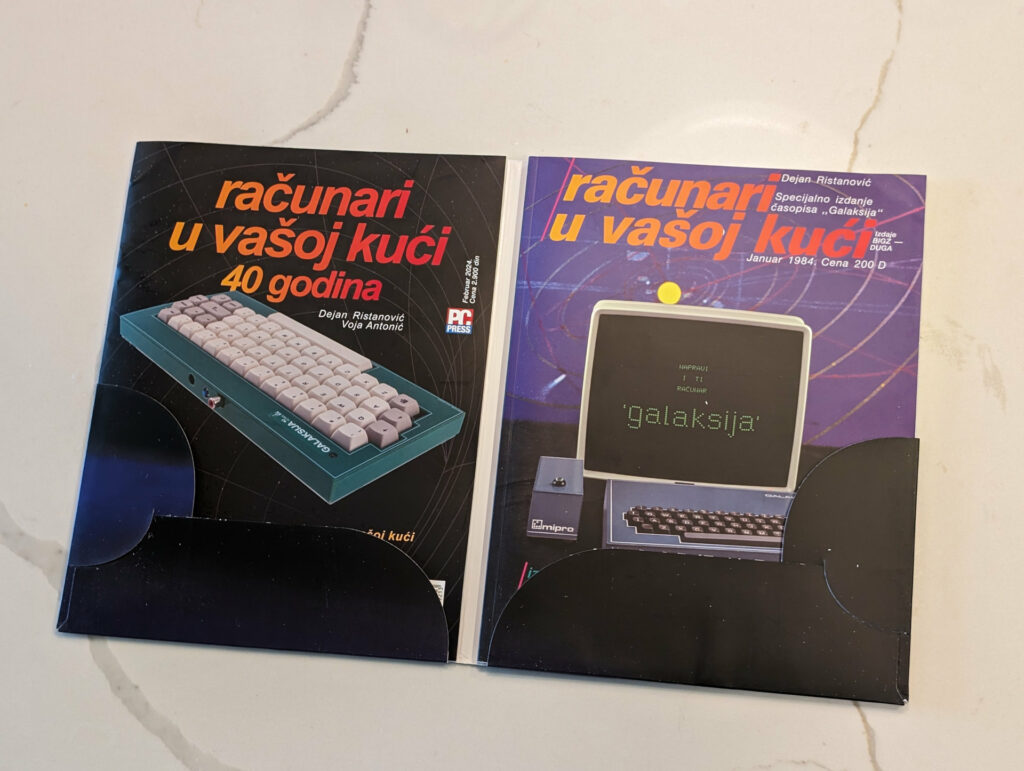
For the 40th anniversary, Dejan Ristanović, the creator of the original Računari u vašoj kući publication, prepared a brand new reprint that painstakingly recreated the original publication from scratch, and re-published it through the PC Press magazine. As Dejan notes in the publication accompanying the re-issue of Računari (appropriately titled Računari u vašoj kući 40 years), the project of reissuing the magazine actually took over 15 years itself – it was first proposed back in the 2000s when a significant chunk of work was completed reverse engineering the typeface and design standards used in the olden, analog days. If you speak Serbian (or with a use of a translator app), the publication describing the 40th anniversary project is a treasure trove in itself – recreating a 40 year old publication with no digital files is an enormous project. Dejan and the team recreated the whole thing from scratch, including taking new photographs of Galaksija assembly and tracking down images originally published in American and British computer magazines which were reproduced back in the 1980s by simply copying them (intellectual property law did not really exist in Yugoslavia). The whole process was so involved, that the team behind the project published an article in the Review of the National Center for Digitization about their effort.
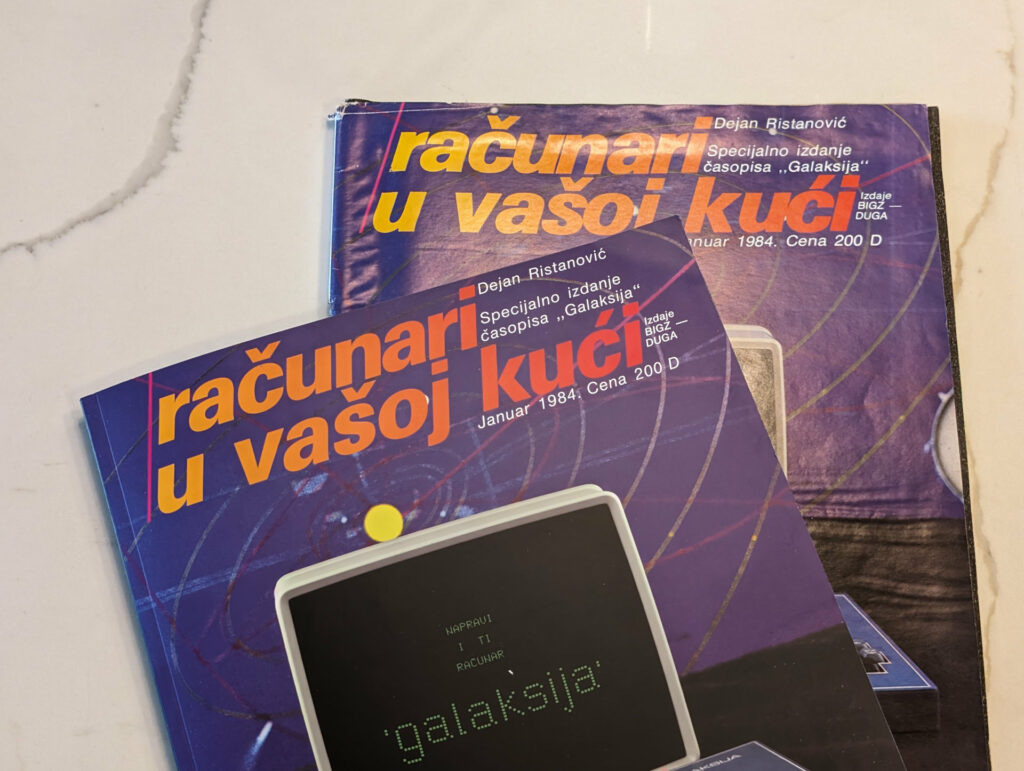
The results are impressive. Računari magazine never looked so good, and you can tell that the whole project was a labor of love and great attention to detail and historical appreciation. In the countless hours I’ve spent researching the history of the Galaksija, I almost exclusively stared at a screen, looking at PDFs, even after I was fortunate enough to obtain the original first issue of Računari u vašoj kući. That physical copy is quite fragile and I would like to preserve it as much as I can. Having this 40th anniversary reprint lets me read through a physical copy without worrying about damaging a historical artifact.
Here are a couple of examples that show the original and the reprint next to each other. Note how closely the reprint follows the original, with subtle but significant improvements in quality!
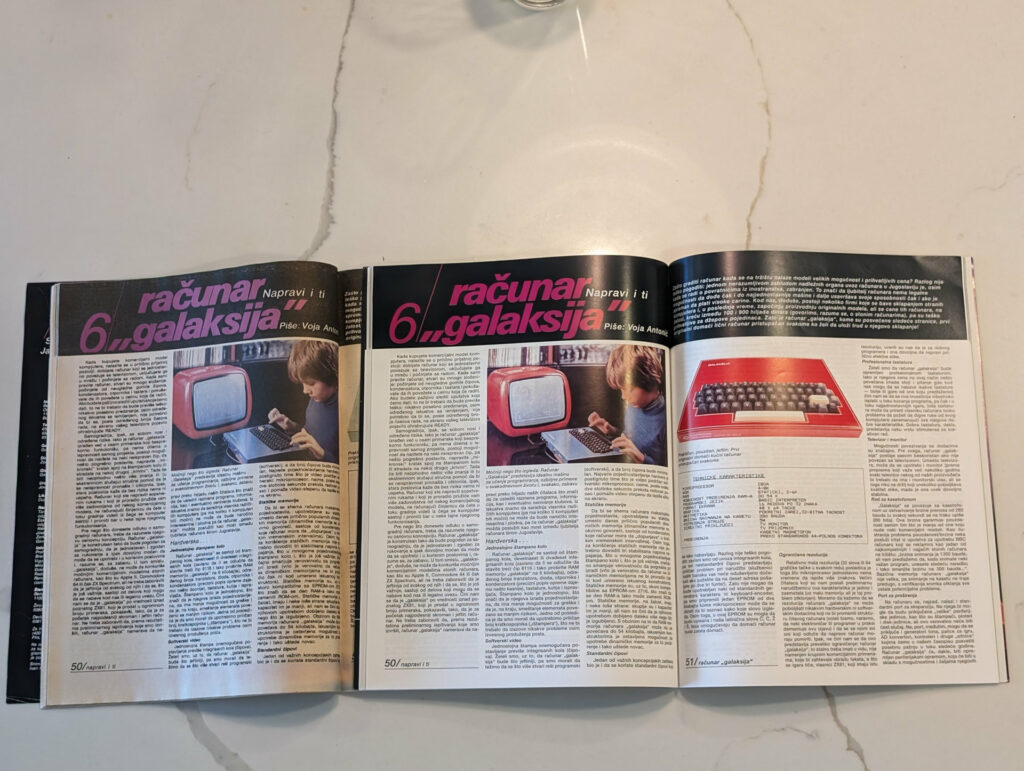
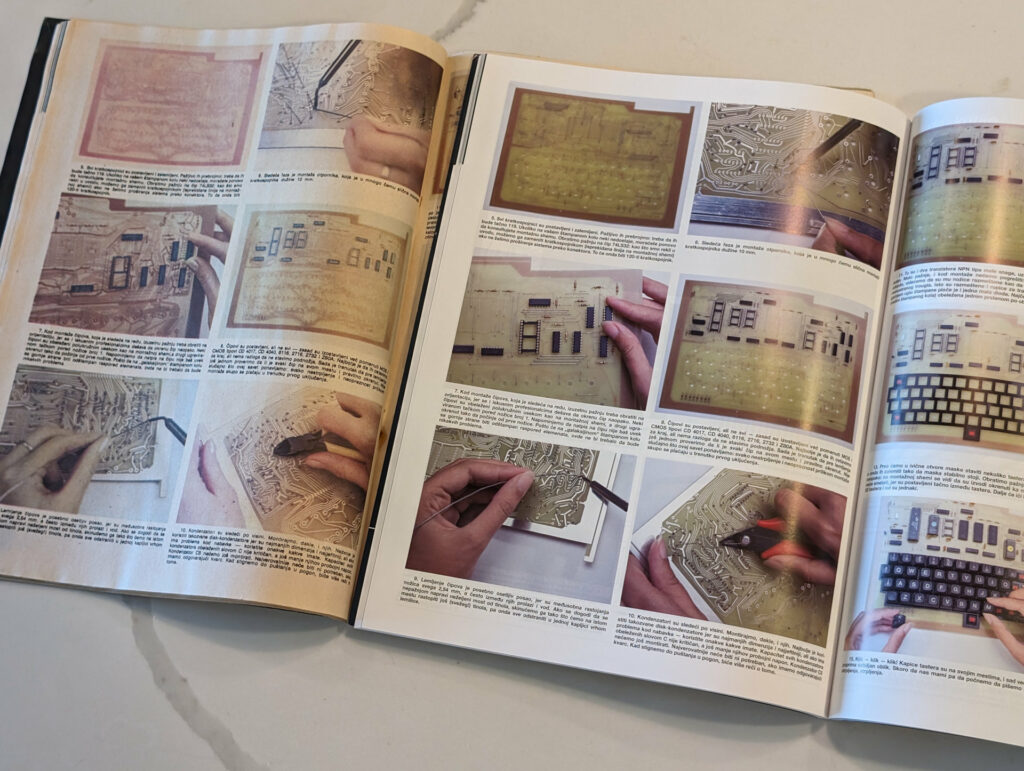
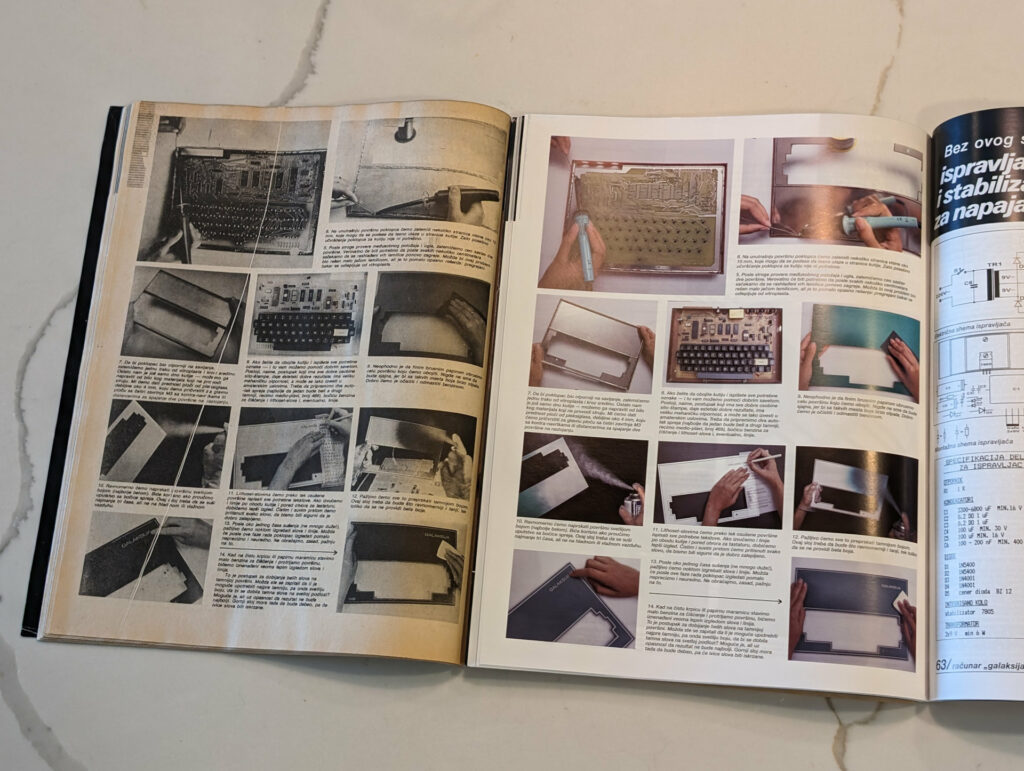
So, how can you get one? Luckily, this re-issue is finally ready after years of preparation! You can order a copy from the PC Press webshop – make sure you use the “za inostranstvo” (for orders abroad) issue if you’re ordering outside Serbia. They take all major credit cards and delivery to the US was quite fast.
Galaksija 2024
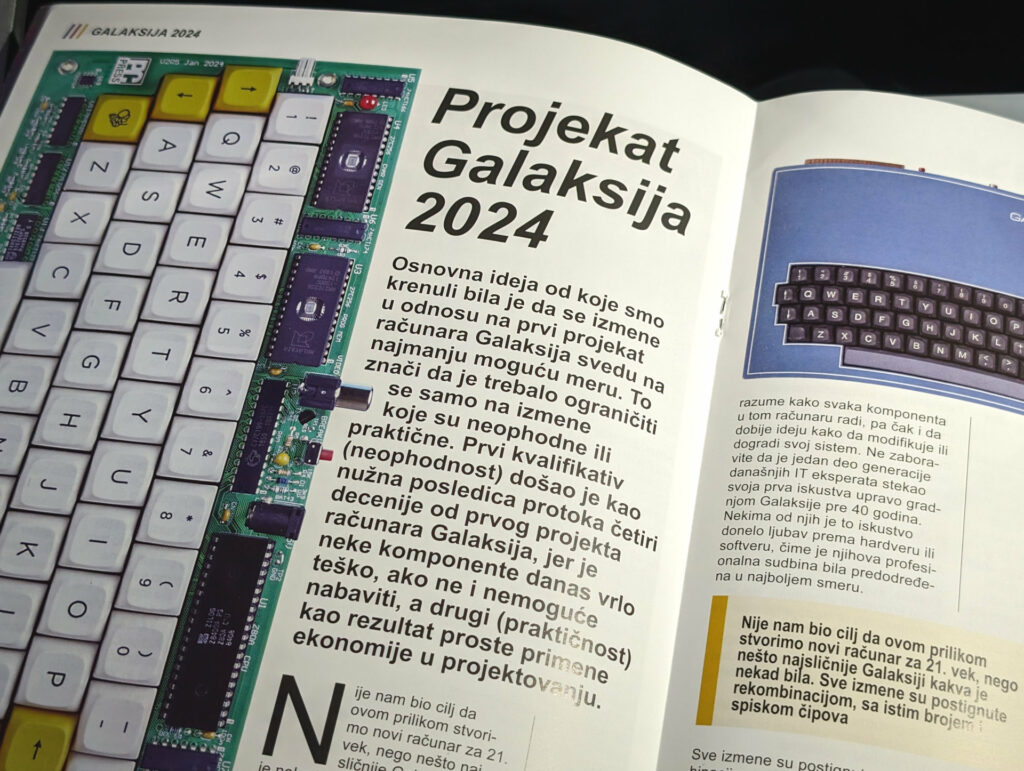
As you read through the accompanying Računari u vašoj kući 40 years publication, you’ll notice that this isn’t just a re-print project. With the same ethos they embodied in 1983, Voja and Dejan included another DIY Galaksija project to mark the 40th anniversary! Galaksija 2024 is unique among modernized vintage computers in a few ways. First of all, it is not a clone or a recreation — it’s a slightly updated design by the same designer of the original: Voja Antonić. It’s also a pretty unique case in terms of technical updates. While a lot of contemporary projects that bring convenient modern features to old computers use modern microcontrollers and components that contain orders of magnitude more computing power than the computers they’re meant to be used with (and there’s nothing wrong with that!), Galaksija 2024 is virtually unchanged from the original, other than a few small but significant details that I’ll go over.
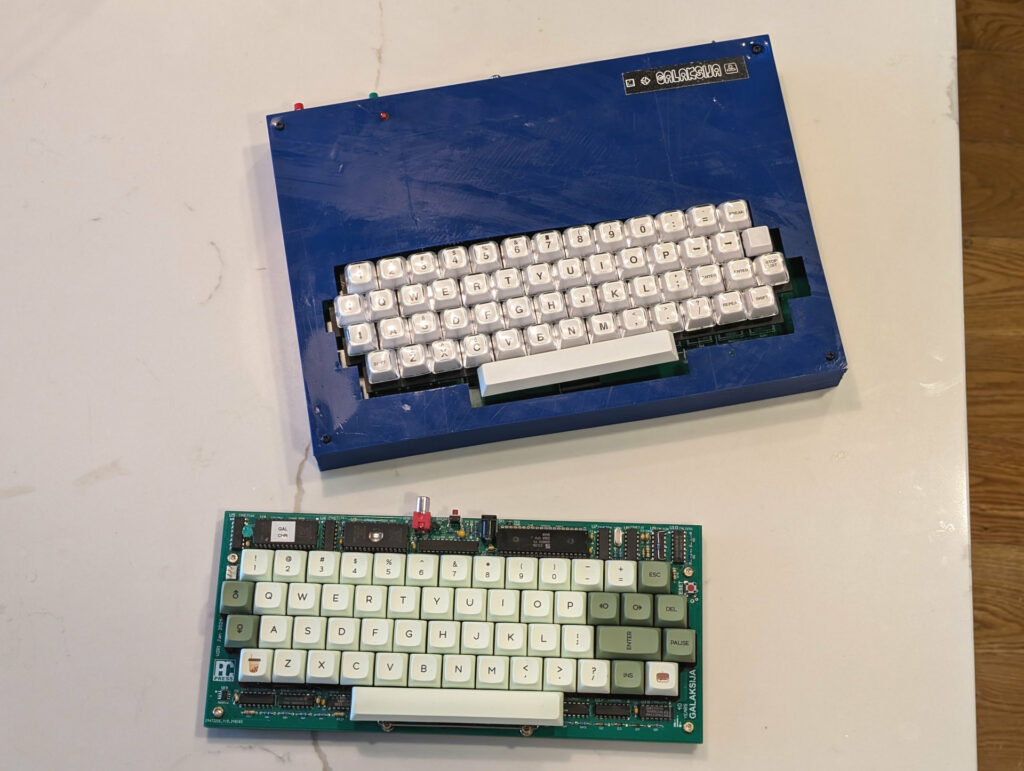
Board design
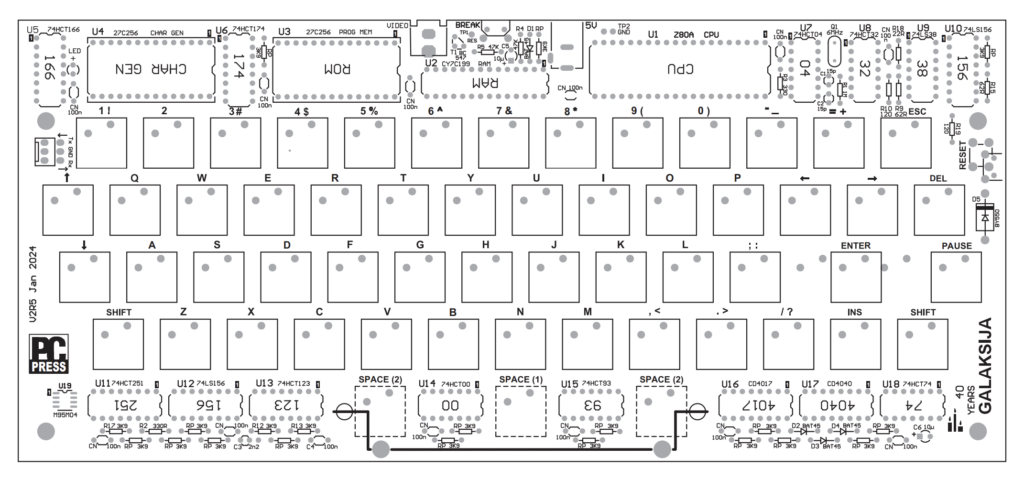
The first thing you’ll notice is that Galaksija 2024 is compact — it’s basically condensed to the footprint of the original Galaksija keyboard. This wasn’t achieved through the use of SMD parts or FPGA or some other modern invention. It’s primarily the result of using a two layer PCB and some very efficient connection routing and parts placement performed by Voja Antonić. This isn’t the first time Galaksija has been updated with a second layer. Voja released a gerbers for a 2 layer Galaksija back in 2020, but this was virtually the same design, updated to use Cherry MX style switches and sparing the builder from having to solder 119 jumpers required by the single board Galaksija. With this new iteration, Galaksija becomes a truly compact Z80 computer. Paired with a small monitor, it almost becomes portable! I’m curious if we’ll see any cyberdeck builds of the new Galaksija.
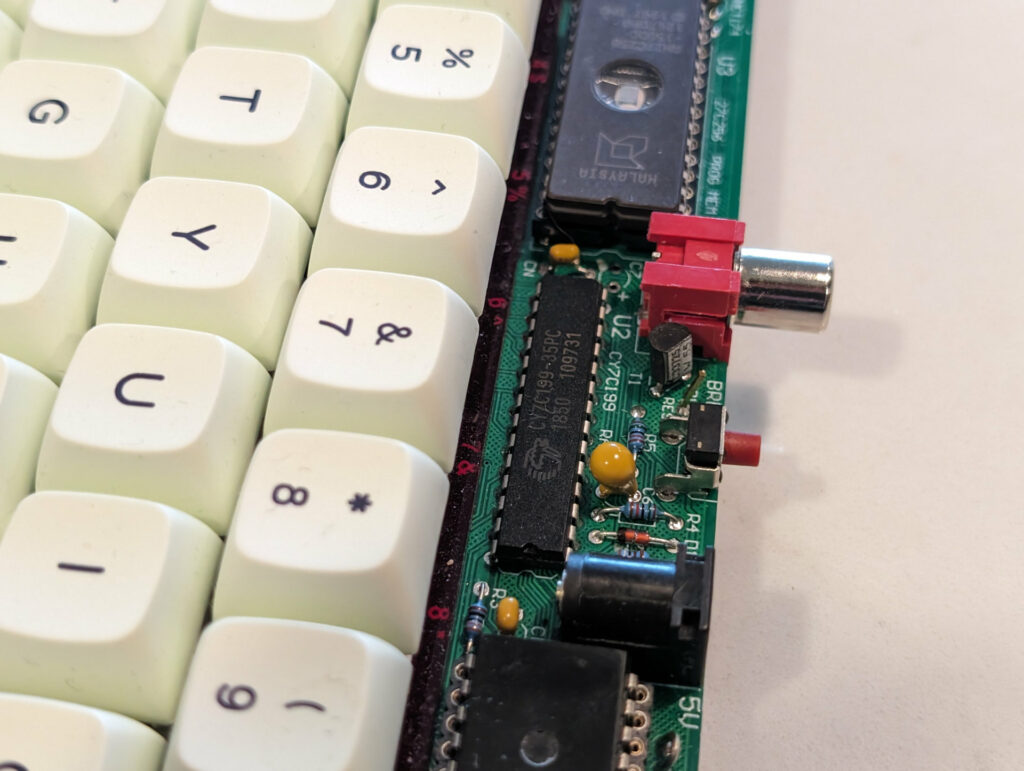
ROM and RAM
The second change is also related to the board design. In 2024, 2732 and 2716 EPROMs are becoming increasingly scarce and expensive, and even when you can obtain them they are quite difficult to program with modern EPROM programmers. Galaksija 2024 is instead built with two 27C256 EPROMs. This helped save space on the board, and also provided additional ROM space. One 27C256 is used for the code from the original ROM A and ROM B + some new functions, while the character generation ROM is stored on the second one (condensing them to a single chip would require additional address decoding logic that would present a significant design change). Additionally, the 3 original 6116 RAM chips are also condensed onto a single CY7C199 32K RAM chip. This also helps save space, and it opens up significant RAM unavailable on the original Galaksija with only 6K of memory. Galaksija 2024 supports a total of 30KB of RAM. These changes however don’t require any significant updates to the hardware design. The only differences are present in software and the memory map, which looks like this on Galaksija 2024:

These changes open up significant RAM and ROM space, but they do come at the cost of losing the expansion port space both in the memory map, and on the board itself. The original Galaksija had an expansion port with direct access to the bus, and a handful of expansion projects were developed for it back in the day. Considering the high cost and limited options of developing traditional expansions for the Galaksija (to my knowledge, none have been developed in recent decades except for those used with the Galaksija Plus clone), the decision to drop support for the expansion port makes sense. And the reason it makes a lot of sense is that Galaksija 2024 introduces a new and much more flexible way to interact with other devices…
EEPROM
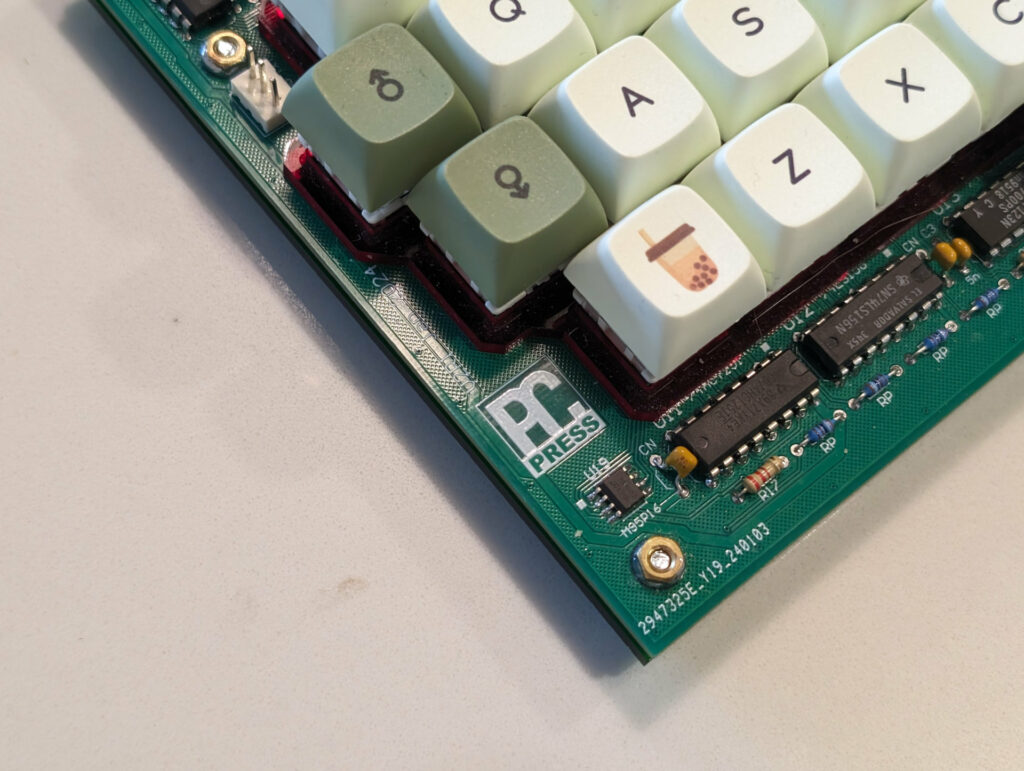
I mentioned that Galaksija 2024 uses the same through hole components from the original. This is mostly true, with one exception. One quality of life improvement Voja introduced on this new Galaksija is a small 4Mb M95M04 EEPROM. Since this component is only available in SMD form, it is the one exception in the design that is otherwise fully true to its 1980s form. Using an EEPROM is fully in the spirit of this computer, and unlike flash memory that often gets used as storage replacement on modern retrocomputing projects, this EEPROM runs on the built-in 5V voltage (supported range is 1.8V – 5.5V) and doesn’t require any special decoding logic. But what is the point of adding this EEPROM to the Galaksija? There was one more small change that makes this computer very usable in 2024…
Serial port
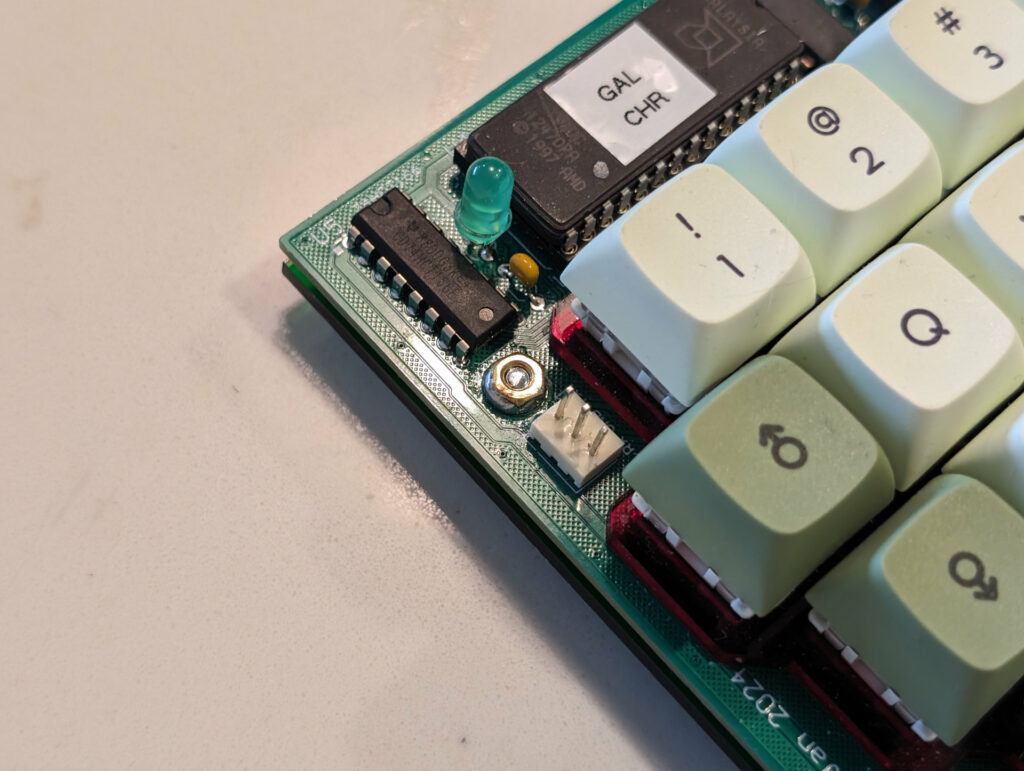
Galaksija 2024 implements a TTL serial port! It features a small UART running at 19200 baud and 3.3V, fully implemented in software with the bitbang technique. The serial port effectively functions as the replacement for the cassette interface and the expansion port in one. With changes in ROM, Galaksija programs can now be loaded via serial in a few seconds. It supports the popular GTP format, and programs can either be sent directly through your favorite terminal emulator or via a python based utility that will soon be released. Once a program is loaded onto the Galaksija, it can be saved to the EEPROM. This way you can build a whole library of programs and easily start them from the EEPROM without a need to connect to a real computer to load a program. I’ve been very fortunate to get to test Galaksija 2024 while the ROM and the utility programs were still in development and I have to say that using a Galaksija with the combo of serial + EEPROM is pure joy. You can now load programs in seconds and actually enjoy using the computer, instead of fiddling with .wav files pretending to be cassette tapes (at least that’s how I’ve loaded most of my Galaksija software until now). 99% of historic Galaksija programs in .gtp format work without issues, but there are a few titles like Superšah that implemented copy protection and don’t yet play nice with loading over serial. I’m sure that the community will figure out how to handle a couple of those edge cases as soon as they start playing with this new Galaksija.
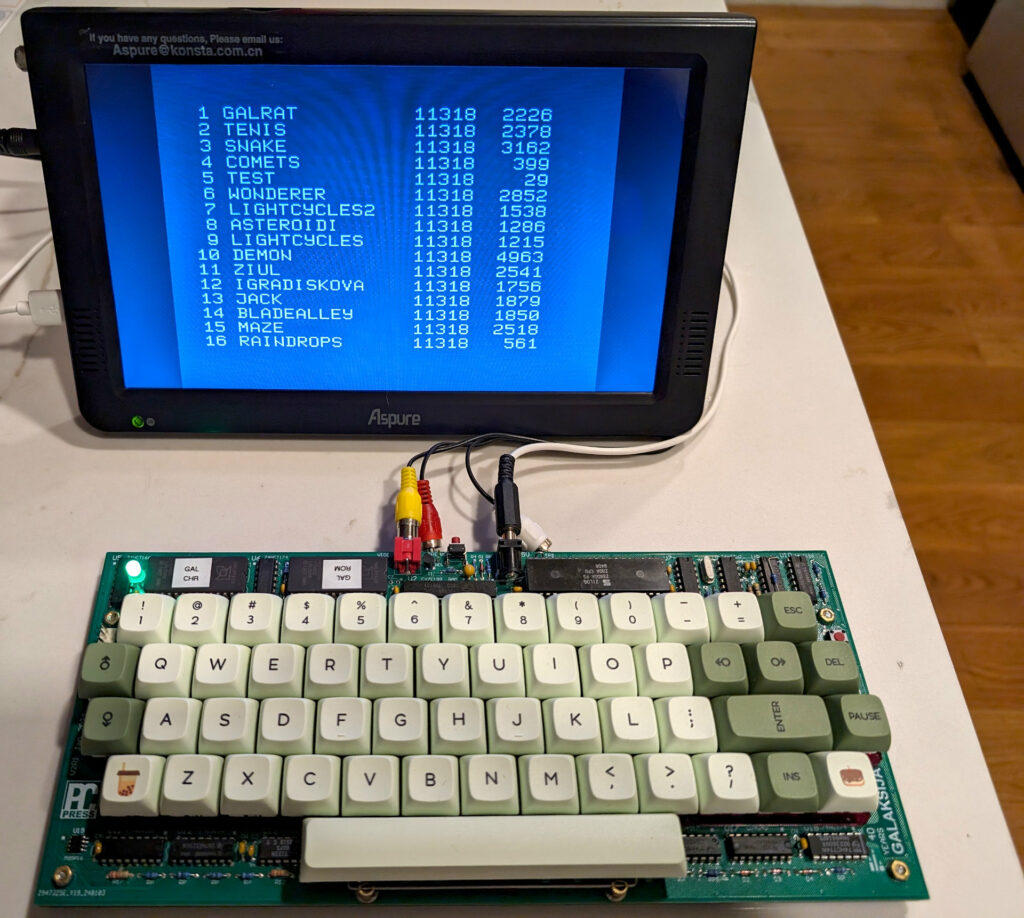
Loading programs through the serial port is only the start. The new ROM implements TX/TY and RX/RY functions, so a whole world of hardware integrations will open up soon. Microcontrollers, terminal emulators, only the proverbial Z80 sky is the limit! This is the feature I am excited for the most on Galaksija 2024 and I can’t wait to see what folks will come up with.
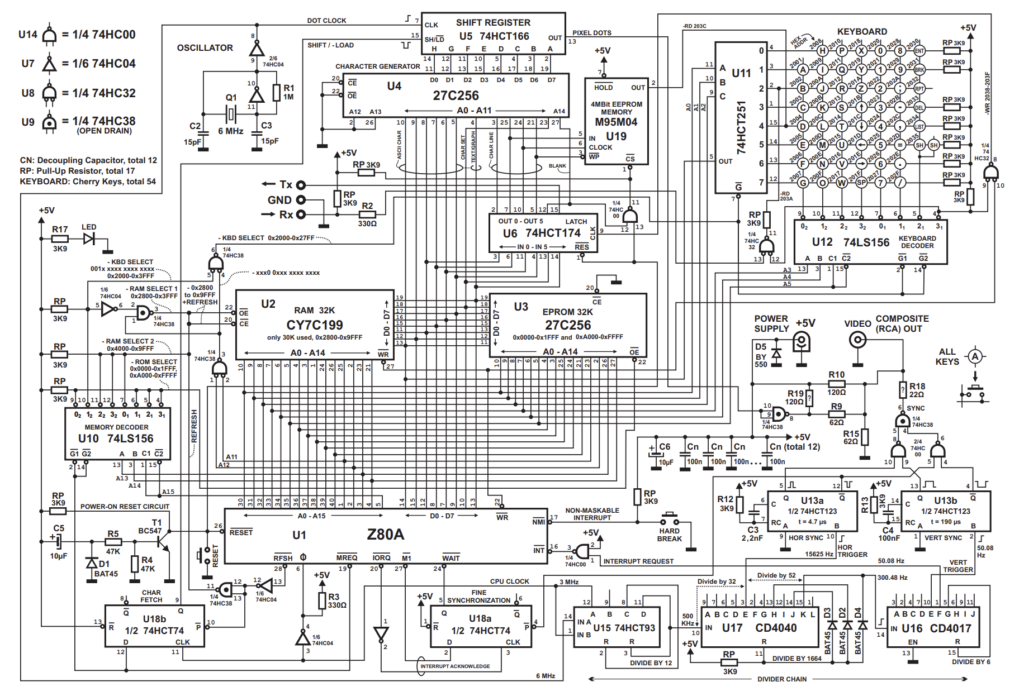
Miscellaneous details
In addition to the major changes outlined above, the new Galaksija features a few smaller updates, all within the scope and spirit of the original, which make it better suited for use in the 2020s.
The first is the use of a 6Mhz oscillator instead of 6.114Mhz in the original. This brings the image generated by the Galaksija fully in line with the PAL standard and makes it much easier to use with modern monitors with composite support, or cheap RCA to HDMI converters. Računari u vašoj kući 40 years publication goes into a lot of detail explaining both how and why this works. For anyone interested in the intersection of analog video and digital logic, the article Voja wrote about Galaksija 2024 is a fantastic resource, written with the same wittiness and easy to understand language of his original instructions 40 years ago.
As with the 2 layer Galaksija from 2020, this new Galaksija uses Cherry MX compatible switches (instead of the impossible to find IEVT TY switches from the original). Interestingly, there are some fun anecdotes in the Računari u vašoj kući 40 years publication about how the original Galaksija ended up with the STOP LIST and REPT keys — they were simply the only ones available from the manufacturer at the time. These days things are very different – there are countless keycap options, but very few of them feature some of the antiquated functions featured on the original Galaksija keys.
Getting a Galaksija 2024
Edit: as of October 2024 you can get a gerbers file for Galaksija 2024 at https://racunari.com/galaksija
So how do you build one? The Računari re-issue features detailed instructions for building Galaksija 2024, but since the hardware design was still going through final revisions, it doesn’t feature the actual PCB design. This is not a problem, since these days we manufacture PCBs from gerbers files, not photocopies from printed magazines (even though maybe we should?). PC Press just announced that they are taking orders for Galaksija 2024 kits through their webshop. Check racunari.com for more info.
Unfortunately, due to customs regulations in Serbia, they will only ship domestically (within Serbia) for now. There is likely a whole another article to be written about how the 40th anniversary Galaksija struggles with the same problems the original one was built to overcome, but I will leave that for another time. For those of you in the EU, the US and elsewhere, I recommend you watch the racunari.com page for announcements on when they might start shipping globally. And make sure to check out the racunari.com/galaksija page which features the schematic, the parts list and other downloads. It will feature the new ROMs soon, and Voja will be releasing the gerbers as well Both the new ROMs and the gerbers files have been released, so everyone can build one by going to their favorite Chinese PCB manufacturer. While you wait, make sure you check out the video on PC Press YouTube channel where Dejan Ristanović unboxes a Galaksija 2024!
Conclusion
With all the recent round anniversaries in computing, I’m so happy to see this project celebrating the Računari magazine and the Galaksija computer, lead by their original creators. Especially given the long period of time when they weren’t given the credit they deserve! The continuation of the public interest in the Galaksija 40 years later shows how its story is still relevant, and this project makes participating in that story more accessible. It’s been a great pleasure and privilege to get to test out the development version of the new Galaksija and I can’t wait to see what people do with it!